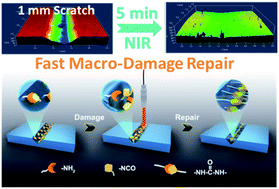NIR driven fast macro-damage repair and shear-free reprocessing of thermoset elastomers via dynamic covalent urea bonds†
Abstract
Achieving macro-damage repair of self-healing polymer materials is highly interesting and rarely reported. Realizing the dynamic characteristics of conventional chemical bonds will generate high-density dynamic covalent bonds in polymer materials, which should be favorable for the macro-damage repairing process as their dissociation can lead to more extensive depolymerization and also more complete disruption of the network. Herein, we accidently found that classical covalent urea bonds formed by primary amine and isocyanate possessed excellent dynamic characteristics in the absence of a catalyst. Density functional theory calculation suggests that the decomposition of a small molecule urea model does not easily occur due to the high energy barrier, while the experimental FTIR study of linear polyurea confirms the occurrence of urea bond decomposition at above 110 °C due to the entropy gain of the flexible polymer chains during heating. We demonstrated a kind of dynamic crosslinked polyurea–polydimethylsiloxane elastomer, in which polydopamine nanoparticles were introduced to produce rapid photo-thermal transition properties. The obtained composite elastomers exhibit a rapid solid–liquid transition under NIR exposure due to high-density dynamic urea bonds present in the polymer network and their fast dissociation rate, and thus possess excellent macro-damage repairing and shear-free reprocessing properties.



 Please wait while we load your content...
Please wait while we load your content...